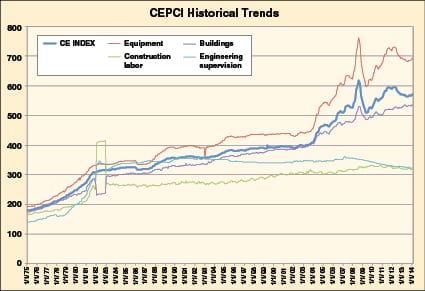Cost estimation is a critical dimension of project planning in asset-heavy industries such as the chemical process industries (CPI). Construction cost indices are useful tools in cost estimation and are used to compare plant construction costs from one time period to another. Understanding them can improve the accuracy of the cost estimates, as well as the effectiveness with which they are applied. This column discusses the use of cost indices and historical trends.
Indices for the CPI
Cost indices are dimensionless numbers that compare prices of a class of goods or services to the corresponding prices at a base period. They are widely used in the construction industry and can be customized to various industry segments.
Predesign estimates are usually made for equipment and assets that will be built in the future, but must be assembled from prices of the past.
The mathematical relationship between costs and indices is the following:
(Cost at Time 1) ÷ (Cost at Time 2) = (Index at Time 2) ÷ (Index at Time 1)
A number of cost indices are relevant to the CPI, including the Chemical Engineering Plant Cost Index (CEPCI) and the Marshall & Swift index (www.marshallswift.com) for the chemical industry and the Nelson-Farrar index (www.ogj.com), which is designed for petroleum refineries.
CEPCI
The CEPCI is a composite index, and is built from four sub-indices: 1) Equipment; 2) Construction Labor; 3) Buildings; and 4) Engineering & Supervision. The Equipment subindex is further broken down into seven component indices, as follows:
• Heat exchangers and tanks
• Process machinery
• Pipe, valves and fittings
• Process instruments
• Pumps and compressors
• Electrical equipment
• Structural supports and miscellaneous
The component indices are compiled with weighting factors and combined to make up the equipment index. The three other sub-indices are compiled independently and also weighted and normalized.
The CEPCI includes the costs to design, purchase and install chemical plant equipment, and is weighted as follows:
• 50.7% equipment, machinery, and supports
• 29% construction labor
• 4.6% buildings
• 15.8% engineering and supervision
Combining the four sub-indices gives rise to the composite CEPCI index. Annual values for the overall CEPCI and for each of the sub-indices are calculated from the arithmetic mean of the monthly values for that year, for each subindex.
The overall CEPCI for 1959 was assigned a value of 100 as a benchmark. Figure 1 illustrates the historical escalation of the CEPCI and its sub-components for the past 37 years. The CEPCI value, along with those for the sub-indices, has risen unevenly, but steadily for the past three decades.

Location factors
Cost indices are traditionally tied to a particular geographic region. As industries and markets globalize, the ability to translate costs has become increasingly important. The cost engineering professional organization AACE International (formerly Assoc. for Advancement of Cost Engineering; Morgantown, W.Va.; www.aacei.org) defines a location factor as an estimating factor used to convert the cost of an identical plant from one location to another. Location factors recognize differences in labor costs, engineered equipment and material freight, duty, taxes, engineering, design and project administration costs. The cost of land is not included in location factors.
Accurately and effectively applying location factors can be challenging and doing so requires an understanding of how each factor was derived and exactly what it represents. In most cases, location factors are not industry-specific, but rather are designed for a broader mix of facility types, so they may not reflect the unique characteristics of buildings in a particular sector. Location factors also typically do not consider cost effects that are associated with site-specific conditions, such as local climate, earthquake risk and other geological differences. Countries may not have the capability to manufacture certain specialized equipment and need to import it, so the degree of importing required needs to be part of the calculation.
When used, location factors should be reserved for preliminary project evaluations — they are not intended to be used when preparing appropriation-quality estimates. Resources for more information on location factors include AACE International and the International Cost Engineering Council (Sydney, Australia; www.icoste.org).
References
1. Ulrich, G.D. and Vasudevan, P.T., Capital Costs Quickly Calculated, Chem. Eng., April 1, 2009, pp. 46–52.
2. Humphreys, Kenneth K., and Hamilton, Allen C. Worldwide Sources of Cost and Project Information. Conference Proceedings, Joint Cost Management Societies, Morgantown, W. Va., 2000.
3. Vatavuk, William M., Updating the CE Plant Cost Index, Chem. Eng., January 2002, pp. 62–70.
4. Pietlock, Bernard A., Developing Foreign Location Factors, Cost Engineering 34(1), January 1992, pp. 7–11.
5. Pietlock, Bernard A., Developing Location Factors by Factoring, AACE International Recommended Practice No. 28R-03, October 2006.
Editor’s note: The editor would like to acknowledge AACE International for allowing access to its virtual library, and EC Harris LLP (London, U.K.; www.echarris.com; an Arcadis company), for insight related to this column.